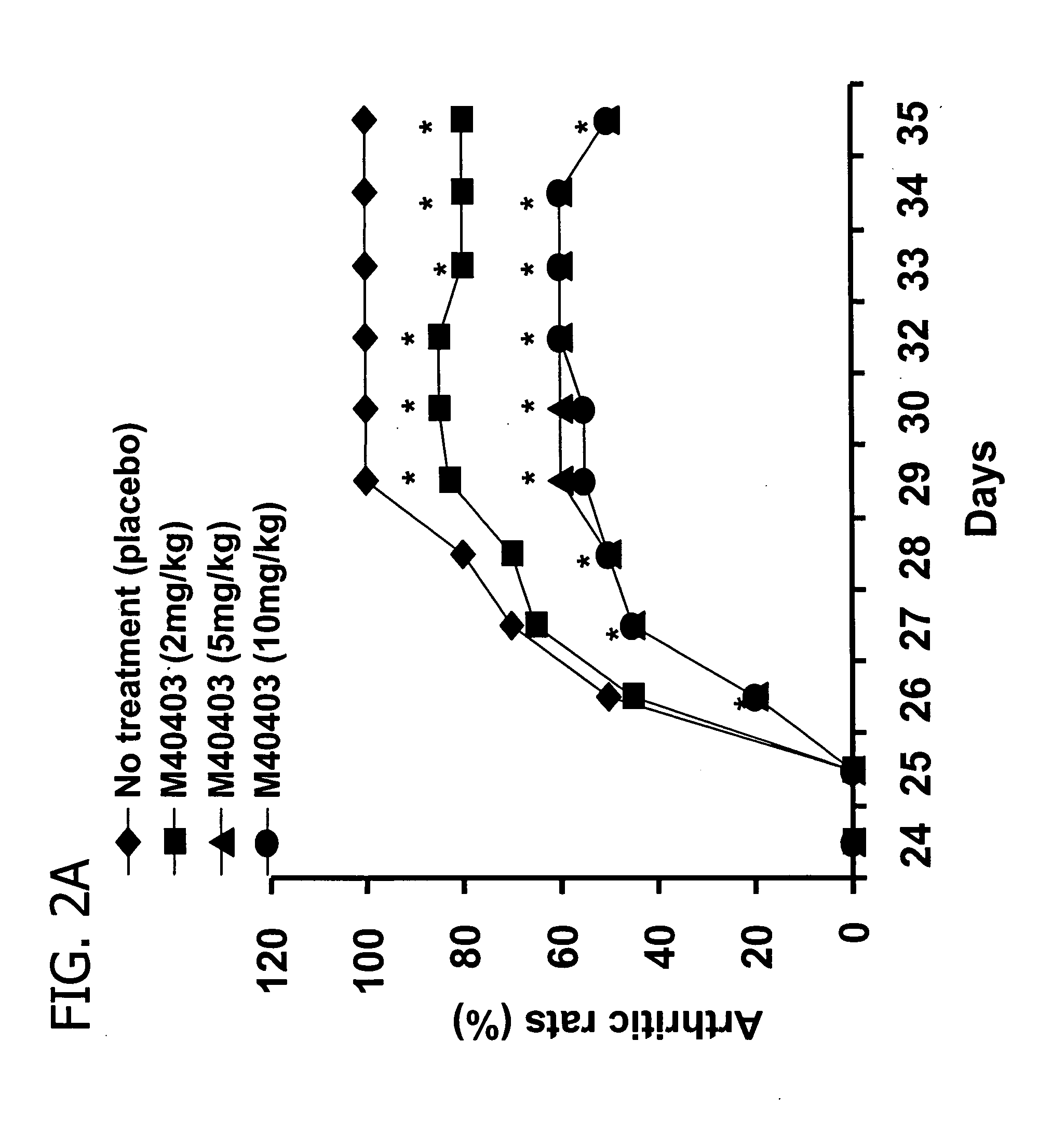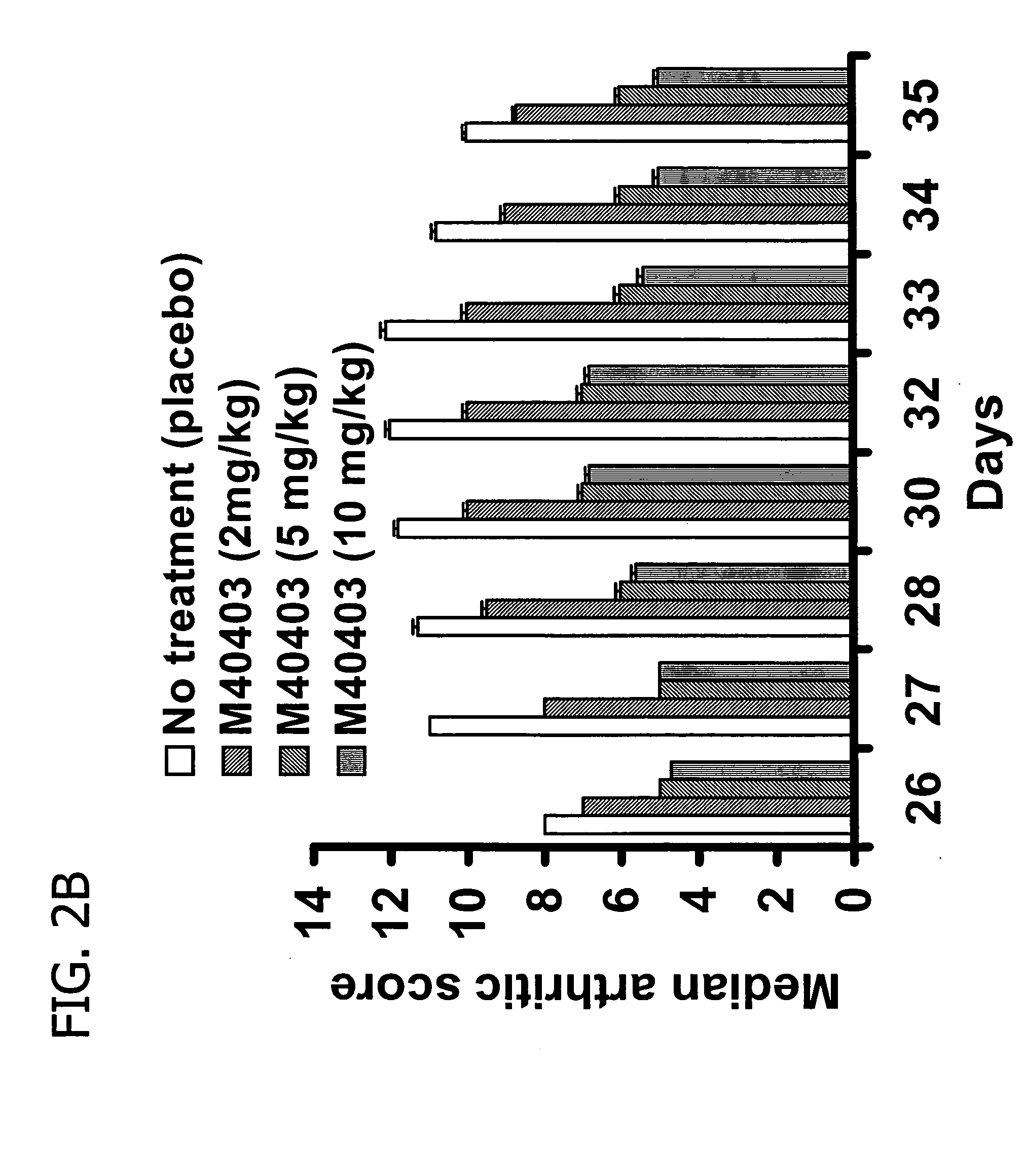SODm therapy for treatment, prevention, inhibition and reversal of inflammatory disease
a technology of inflammatory disease and sodm, which is applied in the field of manganese complex of a heterocyclic pentaazacyclopentadecane ligand, can solve the problems of inability to effectively treat inflammatory disease, attack the body's own cells, and class of compounds, and achieves the effects of less weight, less cytokine levels, and less toxicity
- Summary
- Abstract
- Description
- Claims
- Application Information
AI Technical Summary
Benefits of technology
Problems solved by technology
Method used
Image
Examples
example 1
Carrageenan Paw Hyperalgesia Testing
[0118] Sprague-Dawley rats (175-200 g, Harlan Sprague Dawley, Indianapolis, Ind., USA) were housed and cared for under the guidelines of the Institutional Animal Care and Use Committee. They received a subplantar injection of carrageenan (0.1 mL of a 1% suspension in 0.85% saline) into the right hind paw. At three hours post-carrageenan, when hyperalgesia is normally at a maximum, the test compound was administered intravenously at dosages of from 1-6 mg / kg. Hyperalgesia is assessed at thirty minutes to three hours post-administration of test compound.
example 2
Induction of Collagen-Induced Arthritis
[0119] Male Lewis rats (160-180 g; Charles River; Milan; Italy) were used for these studies. Collagen-induced arthritis was induced as described in Griffiths M. M. et al., Immunogenetic Control of Experimental Type II Collagen-induced Arthritis. 1. Susceptibility and Resistance among Inbred Strains of Rats, Arthritis Rheum. (2): 781-789 (1981) and Tawara T. et al., Effects of Recombinant Human IL-1b on Production of Prostaglandin E2, Leukotriene B4, NAG, and Superoxide by Human Synovial Cells and Chondrocytes, Inflammation (15):145-57 (1991). Bovine type II collagen (CII, Sigma) was dissolved in 0.1 M acetic acid at a concentration of 2 mg / ml by stirring overnight at 4° C. Dissolved CII was frozen at −70° C. until use. Rats were immunized with an emulsion containing 2 mg / ml of CII in Incomplete Freund's adjuvant (IFA). The emulsions were prepared by homogenizing one part CII into one part IFA (Sigma) at 4° C. On day 1, rats were injected intra...
example 3
Suppression of Collagen-Induced Arthritis by M40403
[0120] Animals were randomly divided into five groups (n=16 for each group). The first group (Group 1) was injected intraperitoneally (i.p) with vehicle only (26 mM sodium bicarbonate buffer, pH 8.1-8.3) and served as a naive group. Collagen-induced arthritis was elicited in groups 2, 3, 4 and 5. In groups 3, 4 and 5 rats were treated with M40403 at 2, 5 and 10 mg / kg respectively. M40403 was given intraperitoneally every 24 h starting from day 25. Group 2 received an equivalent volume of vehicle. Rats were evaluated daily for clinical signs of arthritis using a macroscopic scoring system which is based on redness / swelling / deformity of the joint: 0=no signs of arthritis; 1=swelling and / or redness of the paw or one digit; 2=two joints involved; 3=more than two joints involved; and 4=severe arthritis of the entire paw and digits. Arthritic index score for each rat was calculated by adding the four scores of individual paws. The Mean A...
PUM
| Property | Measurement | Unit |
|---|---|---|
| molecular weight | aaaaa | aaaaa |
| molecular weight | aaaaa | aaaaa |
| concentration | aaaaa | aaaaa |
Abstract
Description
Claims
Application Information
 Login to View More
Login to View More - R&D
- Intellectual Property
- Life Sciences
- Materials
- Tech Scout
- Unparalleled Data Quality
- Higher Quality Content
- 60% Fewer Hallucinations
Browse by: Latest US Patents, China's latest patents, Technical Efficacy Thesaurus, Application Domain, Technology Topic, Popular Technical Reports.
© 2025 PatSnap. All rights reserved.Legal|Privacy policy|Modern Slavery Act Transparency Statement|Sitemap|About US| Contact US: help@patsnap.com



